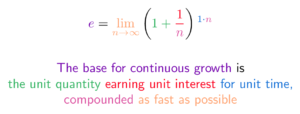A common question is why e (2.71828...) is so special. Why not 2, 3.7 or some other number as the base of growth?
First off, e was discovered, not chosen. Think of the speed of light, c. It wasn't originally decided to be 299,792,458 m/s -- we did experiments and realized under ideal, universal conditions (a vacuum), this was the fastest light could move1.
Let's look at growth and ask under ideal, universal conditions, what's the fastest something can possibly grow? Ideal, universal assumptions would be:
- Growing by the unit rate (100%)
- Growing for the unit time (1 time period)
- Growing perfectly, without any delay (continuous)
Turning these assumptions into a formula, we get:
.png)
If we actually use the formula (using large values of n for more accuracy) we get e = 2.718281828459...
Objection: But $13.74^x$ can model exponential growth just like $e^x$ can!
Sure. But what assumptions did you make to get 13.74? They probably weren't "unit rate, unit time, perfectly compounded". (You can pick k as the speed of light through Kool Aid too -- but why?)
Arguably, $2^n$ is also universal ("the discrete e"), because you have zero compounding (n is an integer like 0, 1, 2, 3). Instead of perfectly continuous, it's perfectly non-continuous (discrete), and we take growth step-by-step.
So, I'd say either $2^n$ (in discrete systems) or $e^x$ (in continuous systems) are "universal".
Objection: But things can grow faster than $e^x$, which is just $2.71828^x$ -- what about $13.74^x$?
What is it with you and 13.74? Yes, you can beat $e^x$ in an exponential footrace, if you use a rate more than 100%. $13.74^x$ is really $[e^{\ln(13.74)}]^x$. Because ln(13.74) ~ 2.6, you are assuming a 260% continuous interest rate, more than the 100% $e^x$ uses. (Alternatively, you can grow for 260% of the unit time period that $e^x$ uses.)
Related:
-
Funny enough, in 1983 c was decreed to be 299,792,458 m/s by redefining the length of a meter. Similarly, you could decide that e is a clean "10" in your base-e number system. ↩
Other Posts In This Series
- An Intuitive Guide To Exponential Functions & e
- Demystifying the Natural Logarithm (ln)
- A Visual Guide to Simple, Compound and Continuous Interest Rates
- Common Definitions of e (Colorized)
- Understanding Exponents (Why does 0^0 = 1?)
- Using Logarithms in the Real World
- How To Think With Exponents And Logarithms
- Understanding Discrete vs. Continuous Growth
- What does an exponent really mean?
- Q: Why is e special? (2.718..., not 2, 3.7 or another number?)
